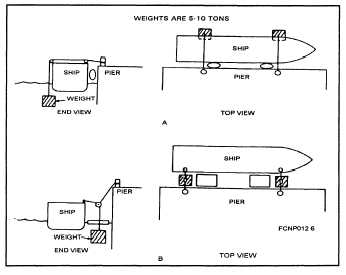Range Calibrator Set AN/UPM-115,
Range Calibrator Set AN/SPM-6,
Radar Beacon Test Set AN/TPN-7 or
AN/UPN-32,
Continuous-Wave Acquisition and Track
(CWAT) Tower Transponder, and
Microwave Power Meter HP 430.
Some of this test equipment is in the process of
being replaced and can be identified in the combat
systems alignment manual that is specific to your
class of ship. A number of additional items of general-
purpose test equipment, such as oscilloscopes, signal
generators, coaxial cables, directional couplers, and
variable attenuators are also used at both the tower
and aboard the ship.
RADAR COLLIMATION PROCEDURES
Shore-tower checks between regular overhaul
periods are generally not performed except when the
Naval Sea Systems Command (NAVSEA) or the
Naval Ship Weapon Systems Engineering Station
(NSWSES) specifies a shore-tower check as a result
of extensive shipyard or alteration work, or after a
microwave casualty occurs that requires microwave
component replacement. On ships outfitted with a
portable ship’s tower, the need for shore-tower service
is established when ship tower checks indicate that
tolerances are exceeded or when correlation data is in
question.
Certain environmental condition requirements
must be complied with before tower operation. These
include the amount of ship motion and the weather
conditions under which the collimation procedures are
performed.
Because ships must be tested while afloat, certain
methods of limiting the motion are used. One method
consists of securing the ship snugly to a pier or dock
4-6
or, in certain cases where excessive ship motion is
created because of tide changes, by using various
weighing methods, as shown in figure 4-7, to reduce
the ship’s motion.
Figure 4-7.—Ship weighting for reducing motion.
Weather conditions must be considered because of
the adverse effects they can have on collimation tests.
For example, visibility between ship and tower, wind
and water action, and heat radiation can affect colli-
mation tests. Visibility should be good between the
ship and the tower. High winds or rough water can
cause ship motion to be so excessive as to invalidate
test results. If refraction due to heat radiation is
observed while viewing an optical target, considera-
tion should be given to rescheduling operations at an
earlier hour of the following day.
The Tartar/SM1 weapons system is employed
aboard several classes of ships. Each class of ships
has a unique configuration of the weapons system
components. Consequently, each class has its own
specific collimation procedures.
This section discusses track-receive axis collima-
tion, track-transmit axis collimation, and CWI axis
collimation. These procedures are discussed only in a
general way and do not address specific procedures
for any particular class of ships.


